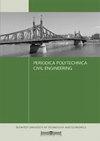Discussion on Blasting Vibration Velocity of Deep Rock Mass Considering Thickness of Overlying Soil Layer
IF 1.4
4区 工程技术
Q3 ENGINEERING, CIVIL
引用次数: 0
Abstract
The thickness of the overlying soil layer has a certain influence on the blasting vibration response of deep rock mass. The vibration wave velocity of the overlying soil layer during the construction of deep blasting is measured in this paper. Based on the measured data, parameters k and α of the Sadowski equation are used to characterize the influence of the comprehensive geological conditions of the site on the vibration wave propagation. The model of blasting vibration velocity of deep rock mass is established according to the existing blasting theory, and the calculation accuracy of the model is verified according to the field blasting parameters. The new model is used to simulate different overlying soil thicknesses, and the safe allowable distance under different soil thicknesses is calculated. The calculated results show that with the increase of the thickness of the overlying soil layer, the blasting vibration velocity decreases and the attenuation velocity decreases gradually. The research results reveal the reduction effect of overlying soil thickness on blasting vibration to some extent. In the area with overlying soil layer, the safe allowable distance of blasting vibration safety can be appropriately reduced to increase the land utilization rate, which has important reference value for the blasting design and safety prediction of deep rock mass.考虑上覆土层厚度的深部岩体爆破振动速度探讨
上覆土层的厚度对深部岩体爆破振动响应有一定的影响。本文对深爆破施工过程中上覆土层的振动波速进行了测量。根据实测数据,利用萨多夫斯基方程参数k和α表征了场地综合地质条件对振动波传播的影响。根据现有爆破理论,建立了深部岩体爆破振动速度模型,并根据现场爆破参数验证了模型的计算精度。利用新模型对不同上覆土厚度进行了模拟,计算了不同上覆土厚度下的安全允许距离。计算结果表明:随着上覆土层厚度的增加,爆破振动速度减小,衰减速度逐渐减小;研究结果表明,上覆土厚度对爆破振动有一定的抑制作用。在有上覆土层的地区,可适当减小爆破振动安全允许距离,提高土地利用率,对深部岩体爆破设计和安全预测具有重要的参考价值。
本文章由计算机程序翻译,如有差异,请以英文原文为准。
求助全文
约1分钟内获得全文
求助全文
来源期刊

Periodica Polytechnica-Civil Engineering
工程技术-工程:土木
CiteScore
3.40
自引率
16.70%
发文量
89
审稿时长
12 months
期刊介绍:
Periodica Polytechnica Civil Engineering is a peer reviewed scientific journal published by the Faculty of Civil Engineering of the Budapest University of Technology and Economics. It was founded in 1957. Publication frequency: quarterly.
Periodica Polytechnica Civil Engineering publishes both research and application oriented papers, in the area of civil engineering.
The main scope of the journal is to publish original research articles in the wide field of civil engineering, including geodesy and surveying, construction materials and engineering geology, photogrammetry and geoinformatics, geotechnics, structural engineering, architectural engineering, structural mechanics, highway and railway engineering, hydraulic and water resources engineering, sanitary and environmental engineering, engineering optimisation and history of civil engineering. The journal is abstracted by several international databases, see the main page.
 求助内容:
求助内容: 应助结果提醒方式:
应助结果提醒方式:


